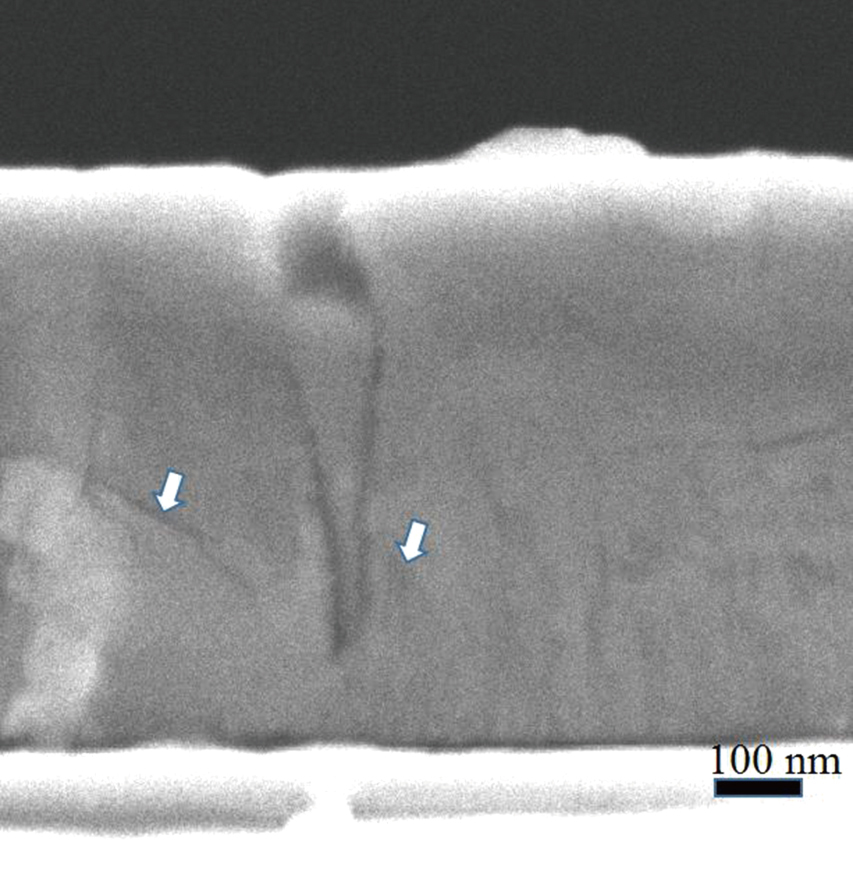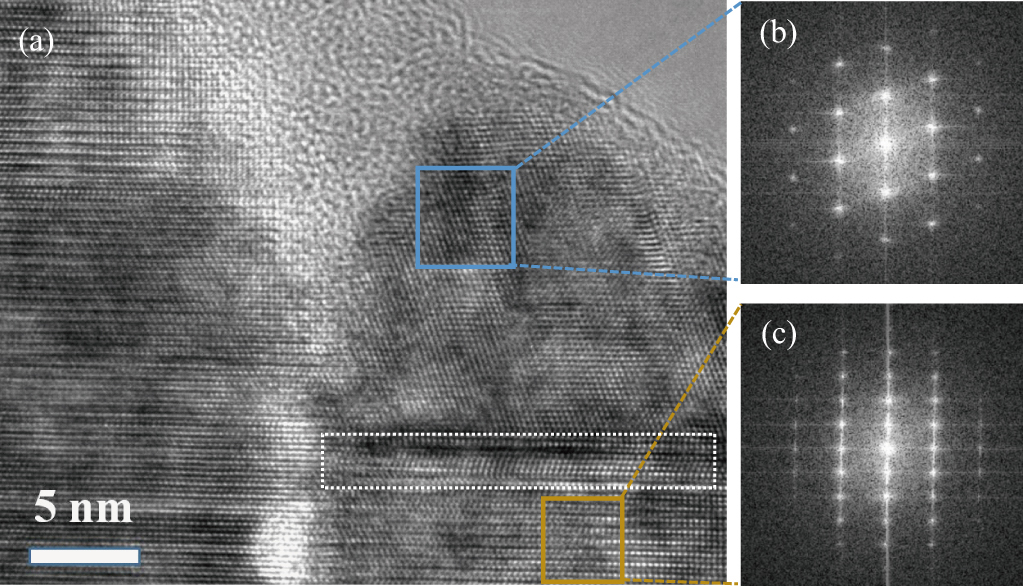† Corresponding author. E-mail:
Project supported by the National Natural Science Foundation of China (Grant Nos. 61604080, 61574079, 61634002, and 61474060), Natural Science Foundation of Jiangsu Province, China (Grant No. BK20160883), University Science Research Project of Jiangsu Province, China (Grant Nos. 16KJB140011 and 14KJB510020), and NUPTSF, China (Grant No. NY214154).
InGaN layers capped with GaN were annealed at 550 °C for 1 hour. During annealing, cracks appeared and dissolved InGaN penetrated through the microcracks into the V-pits to form indium-rich nanoprecipitates. Some precipitates, in-situ annealed under nitrogen ion irradiation by MBE, were confirmed to be cubic GaN on the tops of precipitates, formed by nitriding the pre-existing Ga droplets under nitrogen ions irradiation.
Annealing can reduce hardness, generate phase transition, eliminate defects and residual stress in steel,[1,2] making it the most important processing treatment in metallurgy. These applications of annealing have the same effects on III-nitride semiconductors. Moreover, many researchers have investigated the micro-structural changes of GaN,[3,4] InGaN,[5,6] and InAlN[7] induced by breaking of chemical bonds during annealing. This makes it more attractive to remove the phase separation in rich indium content alloys by annealing.[6,8,9] Besides all that, for GaN related semiconductors, annealing is usually applied to activate dopants[10] and to prepare ohmic contacts.[11]
Though some further achievements on InGaN have been made in recent years,[12–14] several barriers still exist in obtaining indium-rich InGaN alloys. The lattice mismatch and gap of miscibility between GaN and InN are the main barriers to obtaining high crystalline quality InGaN with high indium content. In order to overcome these difficulties, more details of InGaN properties and growth mechanisms should be learned. In fact, the results from annealing, for InGaN alloys, depend strongly on the conditions of annealing.[5,6] But all the processes of indium incorporation or decomposition from InGaN have the identical characteristic that the In–N bonds are weaker than the Ga–N bonds. In this work, a novel nanostructure is reported, which can be considered to be a precipitate of InGaN during annealing. To the best of the author’s knowledge, no research concerning indium-rich precipitates with cone shape in V-pits has ever been reported.
The InGaN structures, shown schematically in Fig.
Surface morphology was characterized by atomic force microscopy (AFM) and scanning electron microscopy (SEM). Chemical composition was measured by x-ray energy spectrometer (EDS) and cathodoluminescence (CL). Transmission electron microscopy (TEM) was applied to examine the microstructure of the InGaN precipitate.
As shown in Fig.
 | Fig. 2. (color online) AFM images of InGaN layers capped with GaN: (a) as-grown, (b) in-situ annealed (S1), (c) ex-situ annealed (S2). |
 | Fig. 3. (color online) SEM images and EDS spectra of annealed samples: (a) S1; (b) S2. The EDS spectra are placed at the bottoms of related SEM images. |
| Table 1. Indium contents obtained by EDS at various positions. . |
Although this morphology of precipitated phase is very common for alloy aging in metallurgy, it is a rather novel phenomenon for III-nitrides. One formation mechanism for precipitates from alloys is always that after annealing, the grain size in alloys will change and precipitates are deposited in grains along some special directions or on some particular fractures.[15,16] Here, a similar situation is suitable for our samples. This kind of precipitate has an intense relationship with the existence of cracks and, up to now, they are never observed in alloys without cracks. As shown in Fig.
In fact, the decomposition at an annealing temperature of 550 °C is selective for InN and GaN. That is to say, the In–N bond can be broken very easily, but it is not so easily for the Ga–N bond to decompose into metal gallium at this temperature. So, for S2, an EDS test on position 1*, shown in Fig.
Note that S1 was treated with in-situ annealing and ion irradiation by MBE, which is rarely studied. So, CL measurements were performed to further investigate the structural properties of S1. As shown in Fig.
 | Fig. 5. (color online) (a) CL mapping for sample S1. CL spectra extracted from positions of (b) 1# and (c) 2#. |
To clarify the origin of 384 nm emission, HRTEM was employed to characterize the precipitates in the pits. It should be mentioned that two crystallographic phases (hexagonal and cubic) are in the precipitate, as shown in Fig.
We have reported a kind of novel nanostructures that filled the pits and are considered to be indium-rich precipitate dissolved out of the InGaN layers during annealing. The high indium-content precipitate, extracted from decomposed InGaN, accumulated in the bottom of pits under influence of the network of micro-cracks nearby. The precipitate, in-situ annealed under nitrogen ion irradiation by MBE, exhibited an emission peak of 384 nm in CL measurements. The emission origin was confirmed to be the cubic GaN on top of the precipitate, which was formed by nitriding the pre-existing Ga droplets under nitrogen ion irradiation.
| [1] | |
| [2] | |
| [3] | |
| [4] | |
| [5] | |
| [6] | |
| [7] | |
| [8] | |
| [9] | |
| [10] | |
| [11] | |
| [12] | |
| [13] | |
| [14] | |
| [15] | |
| [16] | |
| [17] | |
| [18] | |
| [19] | |
| [20] | |
| [21] | |
| [22] | |
| [23] | |
| [24] | |
| [25] |




